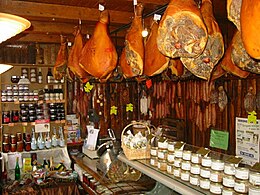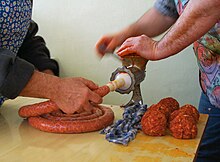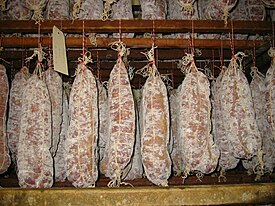What Part Of The Animal Is Vienna Sausage Made Of

Charcuterie hanging in a French shop
Charcuterie ( shar-KOO-tər-ee, besides -EE ; French: [ʃaʁkyt(ə)ʁi] ( ![]() listen ); from chair , 'mankind', and cuit , 'cooked') is a French term for a co-operative of cooking devoted to prepared meat products, such as bacon, ham, sausage, terrines, galantines, ballotines, pâtés, and confit, primarily from pork.[1]
listen ); from chair , 'mankind', and cuit , 'cooked') is a French term for a co-operative of cooking devoted to prepared meat products, such as bacon, ham, sausage, terrines, galantines, ballotines, pâtés, and confit, primarily from pork.[1]
Charcuterie is role of the garde manger chef's repertoire. Originally intended as a mode to preserve meat before the appearance of refrigeration, they are prepared today for their flavors derived from the preservation processes.[two]
Terminology [edit]
The French give-and-take for a person who practices charcuterie is charcutier , mostly translated as "pork butcher". This has led to the mistaken belief that charcuterie can merely involve pork.[ citation needed ] The Food Lover's Companion, however, says, "it refers to the products, particularly (but not limited to) pork specialties such as pâtés, rillettes, galantines, crépinettes , etc., which are made and sold in a delicatessen-style shop, also chosen a charcuterie." The 1961 edition of Larousse Gastronomique defines it equally "[t]he art of preparing various meats, in particular pork, in club to nowadays them in the most diverse ways."
Products created with forcemeats [edit]
Forcemeat [edit]
Forcemeat is a mixture of basis, lean meat emulsified with fat. The emulsification can be achieved by grinding, sieving, or puréeing the ingredients. The emulsification may either be polish or coarse in texture, depending on the desired consistency of the terminal product. Forcemeats are used in the production of numerous items constitute in charcuterie. Meats unremarkably used in the production of forcemeats include pork, fish (thruway, trout, or salmon), seafood, game meats (venison, boar, or rabbit), poultry, game birds, veal, and pork livers. Pork fatback is frequently used for the fat portion of forcemeat, as it has a somewhat neutral flavor.[3]
In The states usage, there are four basic styles of forcemeat. Direct forcemeats are produced by progressively grinding equal parts pork and pork fat with a third dominant meat which can be pork or another meat. The proteins are cubed then seasoned, cured, rested, ground so placed into the desired vessel.[3] State-style forcemeats are a combination of pork, pork fat (oft with the addition of pork liver) and garnish ingredients. The finished product has a fibroid texture.[3] The third fashion is gratin, which has a portion of the primary protein browned; the French term gratin connotes a "grated" product that is browned.[3] The final style is mousseline, which are very light in texture using lean cuts of meat commonly from veal, poultry, fish, or shellfish. The resulting texture comes from the add-on of eggs and cream to this forcemeat.[3]
Sausage [edit]

The word sausage is derived through French from the Latin sal , 'salt', as the sausage-making technique involves placing ground or chopped meat forth with salt into a tube casing. The tube casings tin vary, but the more mutual animal-derived casings include sheep, grunter, or cattle intestinal linings. Additionally, animal stomachs and bladders, too as edible artificial casings produced from collagen and inedible plant cellulose or paper, are used. Inedible casings are primarily used to shape, store, and historic period the sausage.[iv] The ii main variants of sausage are fresh and cooked. Fresh sausages involve the production of raw meat placed into casings to be cooked at a later time, whereas cooked sausages are heated during production and are ready to swallow at the end of production.[v]
Emulsified sausage [edit]
Emulsified sausages are cooked sausages with a very fine texture, using the combination of pork, beef, or poultry with fat, salt, cure, flavorings, and water. These ingredients are emulsified at loftier speed in a food processor or blender. During this process, the salt dissolves the musculus proteins, which helps to suspend the fat molecules. Temperature is an important part of the process: if the temperature rises to a higher place sixty °F (xvi °C) for pork or 70 °F (21 °C) for beef, the emulsion will not hold and fat volition leak from the sausage during the cooking procedure.[v]
Pâté, terrine, galantine, roulade [edit]

Pâté and terrines are often cooked in a pastry crust or an earthenware container. Both the earthenware container and the dish itself are called a terrine. Pâté and terrine are very similar; the term pâté often suggests a finer-textured forcemeat using liver, whereas terrines are more than ofttimes made of a coarser forcemeat. The meat is chopped or ground, along with heavy seasoning, which may include fat and aromatics. The seasoning is important, as they will more often than not be served common cold, which mutes the flavors.[6]
The mixture is placed into a lined mold, covered, and cooked in a water bathroom to command the temperature, which will keep the forcemeat from separating, as the h2o bathroom slows the heating process of the terrine. Pâté and terrine are mostly cooked to 160 °F (71 °C), while terrine made of foie gras are generally cooked to an internal temperature of 120 °F (59 °C). After the proper temperature is reached, the terrine is removed from the oven and placed into a cooling unit of measurement topped with a weight to compact the contents of the terrine. It is so allowed to rest for several days to permit the flavors to blend.[6]

Galantine is a chilled poultry product created after the French Revolution by the chef to the Marquis de Brancas. The term galant connotes urbane sophistication. Other origins are suggested: the older French word for craven géline or galine or the word gelatin. Sources advise the spelling of gelatin transformed into the words galentyne, galyntyne, galandyne, and galendine.
The galantine is prepared by skinning and boning a chicken or other poultry. The skin is laid apartment, with the pounded chest laid on top. A forcemeat is so placed on meridian of the pounded breast. The galantine is then rolled with the ends of the breast meeting one some other. The galantine is then wrapped in cheesecloth and poached in poultry stock until the proper internal temperature is reached.[7]
Roulade is similar to a galantine. The 2 major differences are instead of rolling the poultry evenly for the ends of the breasts to encounter, the bird is rolled into a pinwheel shape, and the roulade is cooled by spooky it after information technology has been removed from the poaching liquid.[7]
Salt-cured and brined products [edit]
Salt serves four master purposes in the preservation of food in the charcuterie kitchen. The first is inducing osmosis: This process involves the motion of water outside of the membranes of the cells, which in turn reabsorb the salted water back into the cell. This procedure assists in the destruction of harmful pathogens. The second is dehydration, which means the table salt pulls backlog water from the protein, which aids in the shelf life of the poly peptide, equally in that location is less moisture present for bacterial growth. Fermentation is the third, in which common salt assists in halting the fermentation process which would otherwise completely break the meat downwards. Finally, salt assists in denaturing proteins, which in essence means the construction of the proteins is effectively shifted, similar to the furnishings of cooking.[8]
Before the discovery of nitrates and nitrites by German chemists effectually 1900, curing was done with unrefined table salt and saltpeter. Every bit saltpeter gives inconsistent results in preventing bacterial growth, nitrate and nitrite (in the forms of sodium nitrite and sodium nitrate) take increased in popularity for their consequent results. Nitrates accept a considerably longer menstruation of fourth dimension to break downwards in cured foods than nitrites. Considering of this, nitrates are the preferred curing salts for lengthy curing and drying periods. Nitrites are frequently used in foods that crave a shorter curing time and are used for any particular that will exist fully cooked.[nine] Eventually, a portion of the nitrates will exist converted into nitrites[10] by bacterial action.
Nitrite has multiple purposes in the curing process. Ane purpose is flavor, the nitrites giving a sharp, piquant flavor to the meat. 2d, the nitrites react with substances in the meat to produce nitric oxide. Nitric oxide prevents iron from breaking downwardly the fat in the meat, thus halting rancidity. The binding likewise creates the characteristic reddish color found in most cured meat. Finally, the nitrite inhibits the growth of botulism-causing organisms that would usually thrive in the oxygen-deprived environment in the sausage casing. German scientists originally named botulism poisoning Wurstvergiftung ("sausage poisoning"). The term botulism derives its proper name from the Latin term for sausage.[eleven]
Eating cured and processed meat products has been linked to a small increment in gastric cancer,[12] equally well as chronic obstructive pulmonary disease[xiii] and colorectal cancer. [14] The negative effects are presumed to be caused by nitrates and nitrites, every bit well every bit nitrosamines which are formed past nitrites reacting with meat. These risks are more often than not regarded equally minimal, and regulations in the The states limit ingoing nitrites to 156 parts per million (0.0156%) (less for bacon) as a precautionary measure.[ commendation needed ]
Curing salt blends [edit]
2 chief types of curing table salt mixture are used by the charcutier. The showtime is known by multiple names, including "tinted cure mix", "pinkish cure", "prague pulverisation", or "insta-cure #1". The mixture is 93.75% sodium chloride and 6.25% sodium nitrite. When used, the recommended corporeality is a ratio of 4 oz for each 100 lb (ane kg for each 400 kg) of meat or 0.25% of the total weight of the meat. This blend is colored bright pink to proceed the charcutier from confusing the mixture with regular salt.[15]
The second curing table salt alloy is called "prague powder Two" or "insta-cure #2". Also colored pink to differentiate it from tabular array salt, it contains 6.25% sodium nitrite, 4% sodium nitrate, and 89.75% tabular array common salt. This mixture is used for dry sausages that crave a longer drying period which requires the presence of nitrate.[15]
Seasoning and flavoring agents [edit]
Sweeteners and other flavoring agents are necessary in the production of many cured products due to the harsh flavors of the salt. A number of sweeteners can exist used in curing foods, including dextrose, sugar, corn syrup, dear, and maple syrup. Dextrose is seen oftentimes in cured meat, as information technology not simply mellows the harshness, but it also increases the wet content of the cured production while calculation less sugariness to the cured meat. The sweeteners also assist in stabilizing the colors in meat and help the fermentation process by giving a food to the leaner.[16]
Numerous spices and herbs are used in the curing process to help with the flavor of the final product. The sweet spices regularly used include cinnamon, allspice, nutmeg, mace, and cardamom. Other flavoring agents may include dried and fresh chilies, wine, fruit juice, or vinegar.[xvi]
Fermented sausage [edit]

Fermented sausages are created by salting chopped or ground meat to remove moisture, while allowing benign bacteria to break downwards sugars into flavorful molecules. Bacteria, including Lactobacillus species and Leuconostoc species, break down these sugars to produce lactic acid, which not only affects the flavour of the sausage, merely too lowers the pH from half-dozen.0 to four.5–5.0, preventing the growth of bacteria that could spoil the sausage. These effects are magnified during the drying process, equally the salt and acidity are concentrated as moisture is extracted.
Encounter also [edit]
- Charcuterie board
- Dejeuner meat, also known as cold cuts – Precooked or cured meats that are sliced and served cold or hot
- List of dried foods
- Listing of smoked foods
- Salumi – Italian cured meat products predominantly fabricated from pork
- Smallgoods
- Kielbasa
- Food preservation
- Fermentation in nutrient processing
- Pickling
- Brining
- Curing (food preservation)
- Smoking (cooking)
- Food drying
Notes [edit]
- ^ Ruhlman, eighteen.; The Culinary Institute of America, 3.
- ^ Ruhlman, 19.
- ^ a b c d e The Culinary Establish of America, 299.
- ^ McGee, 169–170.
- ^ a b McGee, 170.
- ^ a b McGee, 172.
- ^ a b The Culinary Institute of America, 317–318.
- ^ The Culinary Found of America, 190–191.
- ^ The Culinary Plant of America, 191.
- ^ McGee, 173.
- ^ McGee, 174.
- ^ Jakszyn, P.; Gonzalez, C. A. (2006). "Nitrosamine and related nutrient intake and gastric and oesophageal cancer run a risk: A systematic review of the epidemiological show". World Periodical of Gastroenterology. 12 (27): 4296–4303. doi:10.3748/wjg.v12.i27.4296. PMC4087738. PMID 16865769.
- ^ "Health - As well much bacon 'bad for lungs'". BBC News. 17 April 2007.
- ^ "What is candy meat? - BBC News". 2015-10-26. Retrieved 2015-11-nineteen.
- ^ a b The Culinary Institute of America, 192.
- ^ a b The Culinary Institute of America, 193.
References [edit]
- The Culinary Institute of America. Garde Manger: The Art and Arts and crafts of the Cold Kitchen. third ed. Hoboken, NJ: John Wiley & Sons, 2008. ISBN 978-0-470-05590-8.
- McGee, Harold. On Nutrient and Cooking: The Science and Lore of the Kitchen. New York: Simon and Schuster, 2004. ISBN 0-684-80001-2.
- Ruhlman, Michael and Polcyn, Brian. Charcuterie: The Craft of Salting, Smoking and Curing. New York: W. W. Norton & Visitor, 2008. ISBN 978-0-393-05829-ane.
External links [edit]
| | Await up charcuterie in Wiktionary, the free dictionary. |
- Enrique García Ballesteros: Foods From Espana History: Charcuterie Through The Ages
- Istituto Valorizzazione Salumi Italiani, PGI Consortium
- Salumi Casalinghi - in Italian
- Salumi -- Italian Common cold Cuts from Nigh.com
Source: https://en.wikipedia.org/wiki/Charcuterie
Posted by: lokencarturestry85.blogspot.com

0 Response to "What Part Of The Animal Is Vienna Sausage Made Of"
Post a Comment